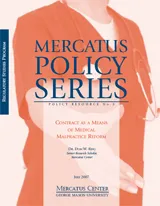In this policy resource, Dr. King provides background material related to medical malpractice law, reviews empirical studies related to malpractice law, and reviews the possible advantages of

Highlights
During the latter half of the twentieth century, the United States experienced a marked increase in the number and value of medical malpractice lawsuits. During the 1990s, a number of studies suggested that malpractice law may not be a very effective means for protecting patients from medical injuries or providing justice for those harmed. A few scholars have suggested that courts allow patients and physicians to allocate the risk of unexpected injury by contract, in advance of care. This approach may offer patients better protection against medical injuries, while simultaneously decreasing costs. This policy resource provides an introduction to medical malpractice law and the possible advantages of allowing patients and physicians to alter medical liability rules in advance of care.
Part One: Tort Law and Medical Injuries (Chapters 1-4)
This section describes the economic foundations and present application of tort law in resolving medical malpractice disputes. Chapter 1 surveys the growth of medical malpractice law in the twentieth century and various proposals for reform. Chapter 2 reviews economic theory related to malpractice law. Chapter 3 examines empirical studies of U.S. malpractice law. Chapter 4 describes features of malpractice law that may limit its effectiveness in resolving disputes and decreasing injuries.
Part Two: Contracts and Medical Injuries (Chapters 5-8)
This section reviews the rationale for and potential use of contracts as a means to reform malpractice law. Chapter 5 reviews the economic theory related to contract law and the potential advantages and disadvantages of using contracts to alter liability rules in advance of care. Chapter 6 surveys several different types of contracts that patients and physicians might adopt if they were certain courts would enforce them. Chapter 7 reviews the potential value that liability-altering contracts may have in deterring injuries, compensating injured patients, and providing justice. Chapter 8 describes impediments to implementing contract-based solutions, as well as a number of approaches for overcoming these impediments.

